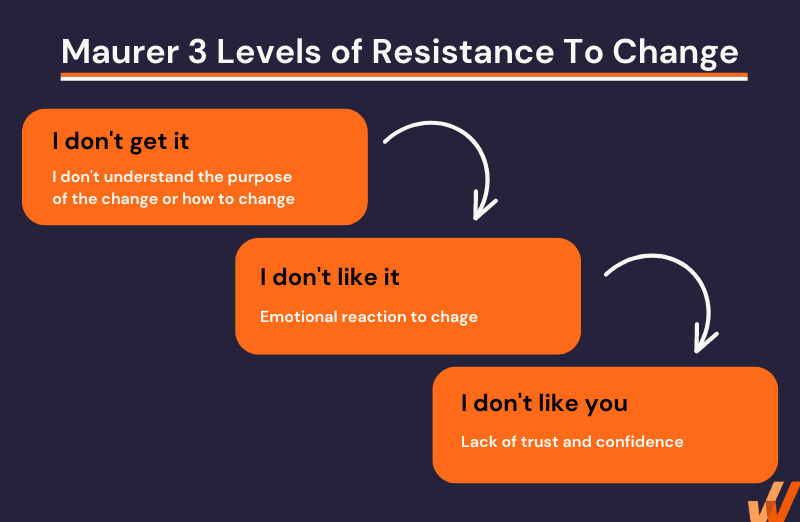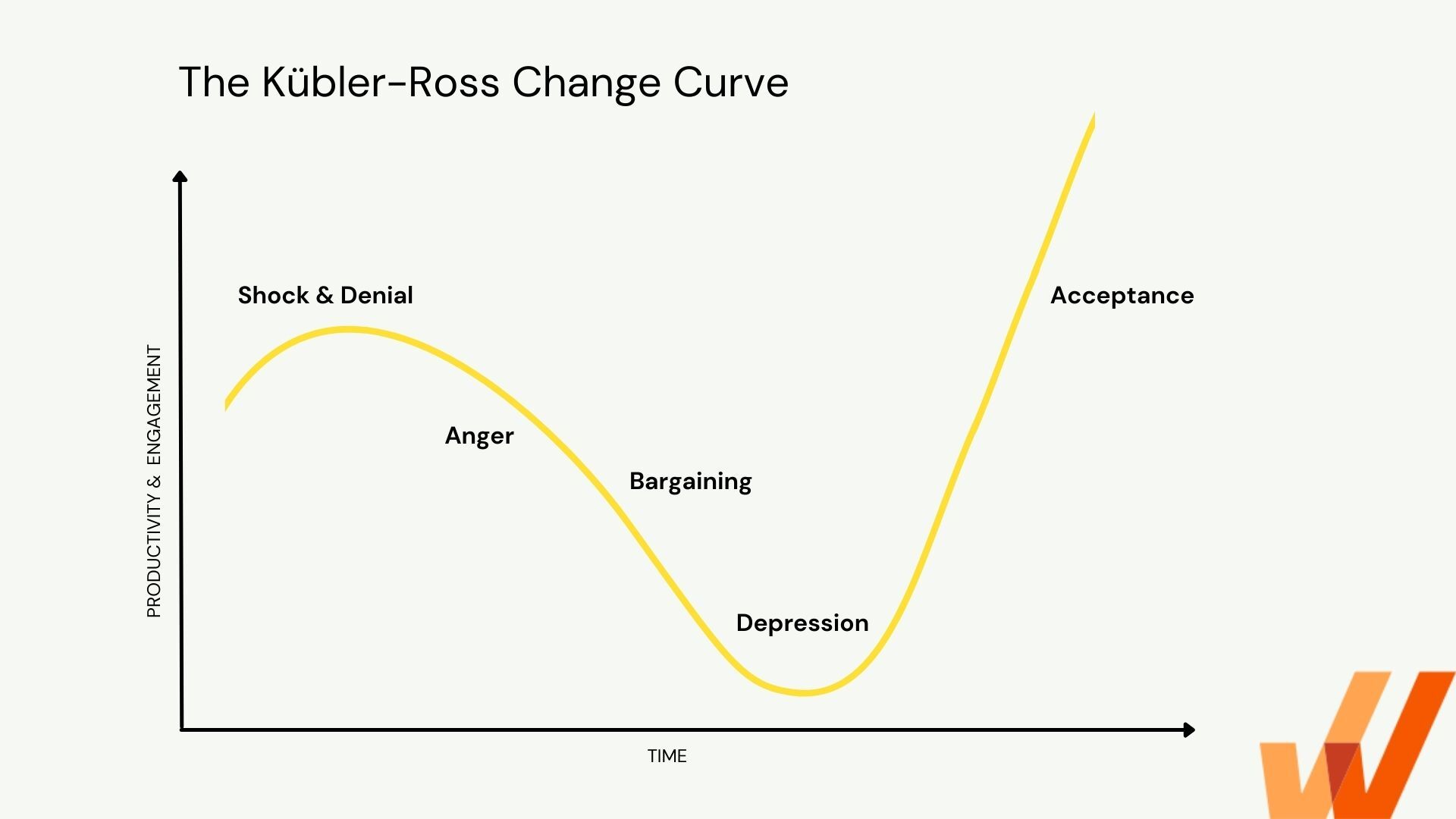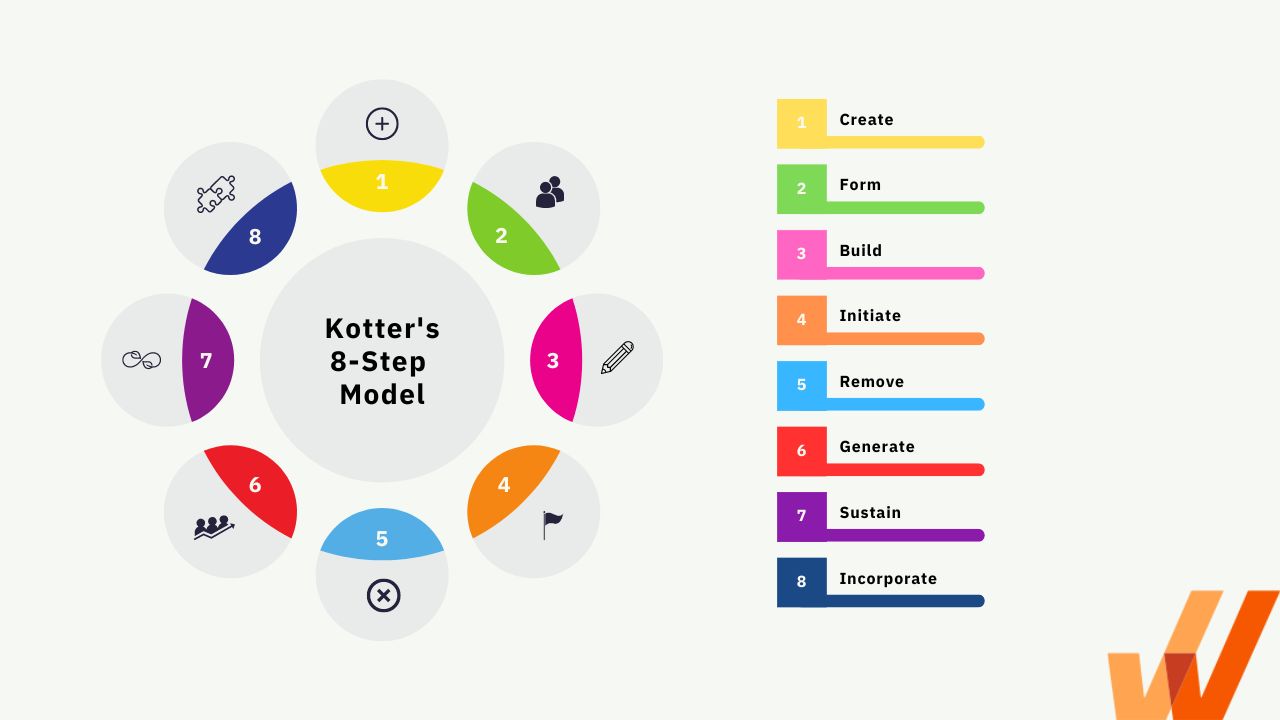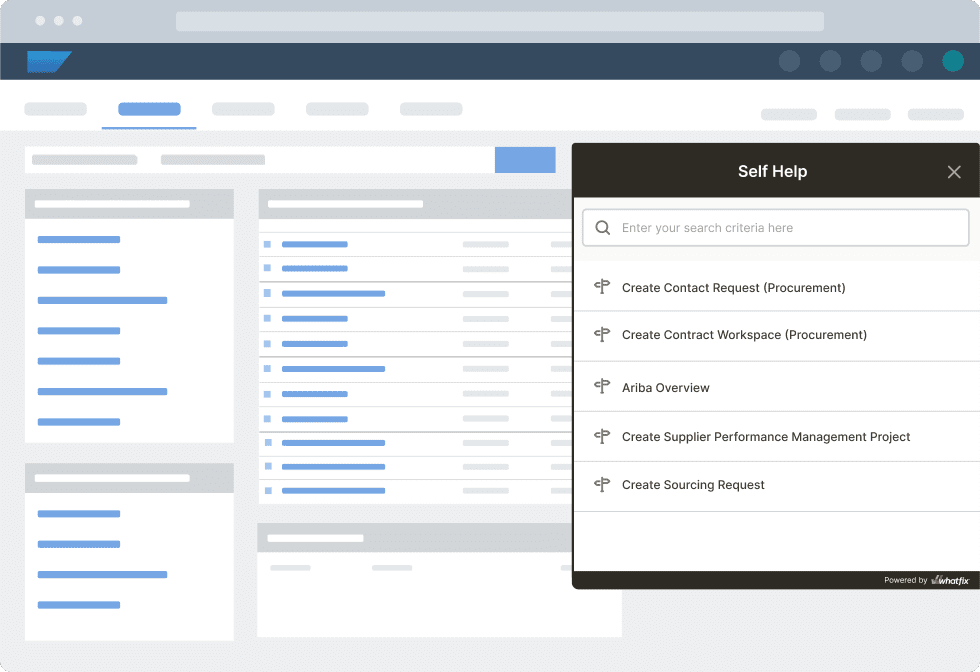Resistance to Change: 7 Causes & How to Overcome Them (2024)
- Published:
- Updated: July 17, 2024


It’s easy to get excited about implementing a change in your organization when you’re the force behind it, but not everyone may share your enthusiasm.
When employees resist change, from using new systems, following a new process, or reporting to a new manager, organizations cannot successfully achieve business outcomes related to the project.
Internal resistance to change can take many forms, including productivity loss, employees quitting, or outright hostility. Factors like employee tenure, scale of change, and team involvement can all influence the level of resistance employees put forwad.
While resistance is natural and inevitable, it becomes more challenging as organizations navigate constant change due to digital transformation and continuous process improvement.
There are ways to support your employees’ willingness to behave and adapt. To overcome resistance, you must understand its reasons and guide past them with a change management strategy that supports your organizational goals and change projects.
In this article, we’ll explore the common reasons for employee resistance to change and how organizations can overcome the barriers to change they present – ultimately driving change adoption.
What are the top causes of resistance to change?
What Is Resistance to Change?
Resistance to change is the reluctance of people to adapt to change. Employees can be overt or covert about their unwillingness to adapt to organizational changes. This opposition can range from expressing their resistance publicly to unknowingly resisting change through micro-resistance, language, or general actions.
Conducting exercises like a force field analysis can help you identify the forces at play causing resistance to change. Following popular change management models can give your organization a framework to understand the “why” behind the resistance and help you overcome it.
✓ Thank you, the template will be sent to your email
What's the Difference in Individual Resistance and Organizational Resistance?
- Individual resistance occurs whens employees resist change based on their unique perceptions, personalities, and needs. Things like job security, habit, and economic factors have a massive influence on individual resistance.
- Organizational resistance is an organization’s tendency to resist change and want to maintain the status quo. Companies that suffer from organizational resistance become inflexible and cannot adapt to environmental or internal demands for change. Some signs of organizational resistance include internal power struggles, poor decision-making processes, unconfident leadership, and bureaucratic organizational structures.
7 Common Reasons for Organizational Change Resistance in 2024
While there can be several reasons why an employee is resistant to organizational change, here are the five most common reasons:
1. Mistrust and lack of confidence
When employees don’t trust or feel confident in the person making the change, their resistance to it can be a huge barrier. Change advisor and author Rick Maurer believes that lack of confidence in change-makers is one of the most overlooked causes of internal change resistance in enterprise organizations.

Maurer’s 3 Levels of Resistance to Change are: I don’t get it, I don’t like it, and I don’t like you. That’s right — people may not resist the change itself, but rather the person making it. Of course, “you” does not always refer to the change-maker specifically. It could also be someone the change-maker represents, such as corporate headquarters or a faceless CEO.
2. Emotional responses
Changing the status quo is complex and people tend to react emotionally to disruptions to their routine. This is a natural and inevitable response. Brushing it off will only lead to stronger resistance.
Use change management models that focus on emotional reactions to change, such as the Kübler-Ross Change Curve or Bridges’ Transition Model, to mitigate this common cause of resistance to change. Both models recognize that change can lead to feelings of loss and grief. As such, change-makers must be prepared to manage these emotions and move people towards acceptance of the change.

Start by coaching change leaders to approach resistance to change with empathy, acknowledging that people may have a wide range of emotional reactions. Some may even skip steps in the Kübler-Ross Change Curve, slide back into old habits, or have negative reactions multiple times throughout the transition.
To manage these reactions, change leaders should clearly explain the need for change while also listening attentively to the feedback from those affected by it. People want to feel heard. Make it clear that their opinions are valuable to the change process.
Change leaders should also check in frequently to provide support, gather additional change feedback, and nudge people toward change acceptance and adoption.
3. Lack of training and help resources
Resistance to change often emerge when employees feel unprepared to adapt and adopt new processes due to a lack of onboarding, upskill training, and end-user support resources to guide them through the initial learning curve and friction points in a new process, team structure, or software implementation.
To overcome internal resistance due to a lack of employee training and support resources, organizations should:
Provide onboarding, reskilling, and upskilling. When making a change, create comprehensive employee training programs that give employees the knowledge and new skills necessary to navigate the transition successfully, whether a new process change or upgrading to a new enterprise application like a CRM or ERP.
Enable employees with self-help support resources. Employees will encounter issues, and your change will most likely be contextual to the point that they cannot find necessary help resources through a simple Google search. Provide thorough documentation on new processes, set up office hours with change leaders, and enable your end-users with IT self-service support resources like Whatfix’s Self Help. Self Help integrates with your process documentation, third-party links, LMS, tutorial videos, and any other support resource and overlays over your digital applications – enabling employees to receive contextual help at the moment of need.
Allocate resources appropriately. Ensure that sufficient resources, such as technology, tools, and budget, are allocated to support the change effort. This helps employees feel empowered and confident in their ability to implement the change effectively. Enterprises must also invest in an internal IT team to help support end-users when they encounter issues. This includes budgeting for dedicated IT team members for internal support issues, as well as digital enablement tools like a digital adoption platform.
Software clicks better with Whatfix's digital adoption platform
Enable your employees with in-app guidance, self-help support, process changes alerts, pop-ups for department announcements, and field validations to improve data accuracy.
4. Fear of failure
People won’t support a change if they’re not confident in their abilities to adapt to it. When people feel threatened by their shortcomings (real or imagined), they protect themselves from failure by resisting the change.
The ADKAR Model has two goals that address the fear of failure: knowledge and ability.

Knowledge is all about effective training. The goal is to give people the tools they need to facilitate the change, including those needed to handle transitions.
Take technological change for example – if your company is integrating a new software system, employees should know how to move existing information into it, as well as how to make the most of the new system in the future.
Ability is more about self-confidence. After training, people need to feel comfortable applying the knowledge they have acquired. Give employees enough hands-on experience to develop and test their new skills before fully launching the change.
5. Poor change communication
The key to excellent change management communication is to create an active conversation. When you talk at people as opposed to with people, you’re bound to get pushback and resistance to change.
Start by making a change communication plan. Before you initiate change, you should have several communication actions planned, such as the announcement of the change, small group discussions, one-on-one meetings, and methods for gathering feedback.
When talking with employees about change, answer the questions, “What’s in it for me?” (WIIFM) and “What does it mean to me?” (WDIMTM). When you address individual concerns, you increase their engagement. People want to know how the change will impact them specifically and what they will need to do to implement and solidify the change.
Furthermore, providing continuous motivation throughout the change process is essential. Kotter’s 8-Step Change Theory highlights the importance of focusing on short-term wins in step six of the eight-step change process. When employees are recognized for their efforts, it builds their enthusiasm and desire to support the change

6. Unrealistic timelines
Find a balance between creating a sense of urgency and allowing time to transition. Don’t force change too quickly – when you push too hard for a change to happen, it’s easy to get tunnel vision and neglect important elements of your change plan.
Start with a change implementation timeline. Map out every action and set deadlines so you have a general idea of how long the entire transformation will take. Often, designing the path between the current state and change adoption helps you identify additional steps needed to facilitate the transition.
Of course, you shouldn’t be afraid to make adjustments. If your team needs more time to understand the change or would benefit from additional change management training, make it happen.
7. Existing organizational culture and norms
Resistance to change often occurs when existing company culture and norms are deeply rooted in an organization, which hinders the acceptance of new ways of doing things, such as new processes, leadership, team structure, or technology.
To overcome this change resistance challenge, enterprise should:
Foster an adaptive, agile, open-minded, learning-centric culture. Foster an environment that values continuous improvement and innovation. Encourage employees to share their ideas and perspectives and reward those who embrace change. Invest in frameworks and technology that enable your employees to be continuously learning.
Lead by example. Demonstrate change at the leadership level by modeling your desired behavior change from the top down. When leaders actively participate in and support a change, it sets a positive example for others to follow and creates a sense that “we’re in this together”.

7 Tips to Overcome Resistance to Change
Here are a few of the best strategies to overcome change resistance in your organization.
1. Show value through education and training
To avoid change resistance, provide proof that a new process, tool, or change will greatly benefit your employees. Prioritize educating your teams on how this new change will directly make their lives better and improve their day-to-day, and provide ongoing training to ensure they feel confident and comfortable navigating the new change.
2. Collect employee input prior to change
Many times, employees resist change because they believe their opinion doesn’t matter and wouldn’t impact the decision to make an organizational change. Run surveys with your team on how they feel about the change and how they would make the process easier.
3. Come to an agreement with your employees
Never make a decision without consulting those on the front lines – your employees. After consulting with your team, come to an agreement on the timeline and overall plan for managing and implementing a new change.
4. Include employees in the change management plan
Employees feel they are taken seriously and their opinion matters when they’re included in processes. Be sure to add key members of your team into the change management and implementation process so they feel ownership of the project. Team members should also be involved when setting change management KPIs and metrics that will determine success.
5. Support your employees during organizational transformation
Don’t leave your employees out on an island – support your team members with resources, change management tools, knowledge bases, and training on the new process or tool you’re implementing. This will help your employees find value in a new system quickly, causing them to build trust with you when it
6. Communicate clearly and frequently
Letting employees know about changes to the status quo as soon as possible helps to build a bridge between employees and management.
Share any information you have with employees that you are able to share. If you’re not sure about an answer or simply cannot provide an answer, it’s okay to say something like, “I’ll look into that and follow up with you” or, “I’ll share that information with you as soon as I have it.” The more open and honest your communication with them, the less likely they are to speculate and spiral.
7. Measure the performance of your organizational change
Measurement is a key factor in the change process because it allows organizations to understand how the implementation influences overall business performance. If something doesn’t go as planned, there’s an opportunity to change it or include it in the next phase of the change implementation.
Anticipating and planning for resistance is essential to implementing positive organizational change. When you dig into the reasons behind the resistance to change, you’re better prepared to address it and move past it, regardless of which type of organizational change you undergo within your company.
Organizations must support their employees through times of change with contextual guidance and assistance at the moment of need.
Whatfix is a digital adoption platform that provides organizations with a no-code editor to create in-app guidance and support in the flow of work to help employees quickly become familiar with new enterprise software, adopt new processes, and drive technology ROI.

With Whatfix, create in-app experiences that overlay your enterprise software and digital workplace, like:
- Tours and Task Lists to provide contextual onboarding for new employees and to support team members during software implementations or migration projects.
- Flows that walk end-users step-by-step through complex workflows or infrequently completed tasks with interactive guidance.
- Smart Tips that provide additional context at critical friction points in a process and enable end-users with contextual knowledge.
- Pop-Ups to make team announcements, drive awareness of process changes, remind employees of deadlines, alert team members to new training, and more.
- Self Help provides an employee resource center that overlays your enterprise applications. It integrates with your SOPs, training documents, LMS, third-party links, and more – providing support at the moment of need.
- In-app Surveys to collect employee end-user feedback on change projects, new processes, training effectiveness, and more.

Understand how users engage with your Whatfix content with Guidance Analytics, providing detailed insights into content consumption and guidance engagement.
Understand how many employees are completing a new user Task List, track how many end-users clicked on a Pop-Up, and analyze the most searched Self Help queries to help you identify new support content to create.
With Whatfix Product Analytics, track any custom user event to understand process completion rates and identify areas of user friction. Analyze this data with User Funnels and Journeys, or compare groups of users against one another with Cohorts to understand adoption across teams, regions, or departments.
Use this to take a data-driven approach to digital enablement, helping you to create in-app guidance and support content that supports your employees at critical friction points in your processes. With Whatfix, create a process of continuous optimization on your digital processes that maximizes your digital value realization on enterprise software.
Ready to get started? Request a Whatfix demo!
Software clicks better with Whatfix's digital adoption platform
Enable your employees with in-app guidance, self-help support, process changes alerts, pop-ups for department announcements, and field validations to improve data accuracy.
Thank you for subscribing!
Thank you for subscribing!


